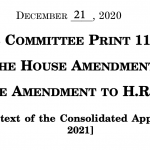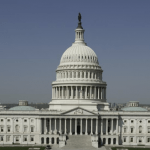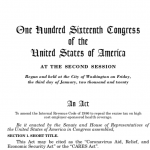The 2021 Covid Relief/Stimulus Bill is Complete – Here Are a Few of Its Provisions
The 2021 Covid relief/stimulus bill is now complete, having passed the U.S. House on March 10, 2021, with its Senate changes intact. It will now go to President Biden on Friday for his signature.
This is a massive piece of legislation, totaling $1.9 trillion in all and including a significant number of policy changes that will likely result in increased costs for many Americans.
True, most Americans will receive a significant amount of financial benefit from this legislation – even though some don’t really need the largesse being provided – but whether that will offset the long-term costs this bill, and those to come, will push onto working-class Americans remains to be seen.
And, don’t forget, the U.S. government doesn’t really have the $1.9 trillion it’s about to spend. In addition to all of the previous Covid relief and stimulus appropriations, this one will go on America’s “credit card,” with the hope that strong economic growth will clear away the accrued debt at some point in the future. Or not.
Those points aside, let’s take a look at some highlights from this current Covid relief/stimulus bill.
If you’re a glutton for punishment, you can read/search the full bill text at this link.
2021 Covid Relief/Stimulus Bill
Stimulus Payments
The primary provision most Americans are interested in is the $1,400 stimulus checks, so here are the specifics on these payments.
As with the previous two rounds of stimulus payments, adjusted gross income based on your federal income tax return – either 2019 or 2020 if you’ve already filed this year – will determine eligibility.
- Individuals with adjusted gross income of less than $75,000 will receive a $1,400 payment.
- Married couples who file their tax return jointly and whose combined income is below $150,000 will receive two $1,400 payments for a total of $2,800.
- Children and adult dependents (this round of payments now includes disabled adults and college students younger than 24) will each receive a $1,400 payment.
- Heads of households will receive the full amount if they earned up to $112,500, and it will phase out completely at $120,000
Unlike previous payments, the income levels for the phaseout of payments has been lowered. Individuals with incomes at $80,000 and above as well as married couples with incomes of $160,000 and above will not receive a payment.
Payments should begin within the next week or so, meaning most Americans who are eligible for a check should see it before April.
Unemployment Payments
The enhancement unemployment payments (payments from the federal government) will total $300 per week, and are in addition to the unemployment payments paid by the state in which you apply.
These enhanced unemployment payments will be paid through September 6, 2021.
And, the first $10,200 of unemployment benefits paid in 2020 will not be taxed for households with incomes below $150,000 per year. Which is a significant benefit to Americans who received unemployment payments last year, only to receive the unwelcome surprise this year that taxes are owed on those payments.
Child Tax Credit
This is a new Covid relief/stimulus provision, if it can be considered one of those, really.
Honestly, this is more of a public policy change, unrelated to Covid, that was included in this bill for ease of the provision’s passage.
The Child Tax Credit increases the payment from $2,000 to $3,000 per child ages 6 to 17. Children under the age of 6 would trigger a $3,600 per child amount.
These payments are for individuals earning $75,000 or less or married couples earning less than $150,000.
For individuals and married couples earning more than $75,000 or $150,000 respectively, the tax credit payments will start to phase out above those income thresholds.
What’s more important about this policy change, for some at least, is that it becomes a fully refundable credit, meaning eligible households will qualify for the full credits even if they don’t earn enough to pay taxes. Previously, the Child Tax Credit was a credit against taxes owed with only a portion refundable if the credit exceeded the tax owed. Now, households with low income levels will receive a check from the IRS for the full amount of the credit(s).
And, the legislative change authorizes periodic payments – monthly payments – rather than a lump sum refund as a result of a tax return filing.
This Child Tax Credit change is written in the bill to be effective for 2021 only.
I would expect this provision to become permanent as a result of future legislative action, though. Stay tuned to see how this plays out.
Housing Assistance
The bill includes $27 billion in emergency rental assistance and $10 billion for mortgage assistance.
These amounts are in addition to the $25 billion that was part of the last relief/stimulus bill passed in December.
It is likely the same process that was included in the previous bill will be followed with this one…individual states will establish the specifics of assistance payments, with monies going directly to landlords. It’s not clear how the mortgage relief would work, though.
And a few bullet points for notable appropriations.
- $90 billion for various activities targeted at improving public health and responding to Covid such as, vaccine programs, testing and tracing and community health centers
- $130 billion to K-12 schools
- $350 billion to state and local governments
- $7 billion for Paycheck Protection Program forgivable loans
- $25 billion for restaurants, bars and other eligible providers of food and drink
- $15 billion for targeted Economic Injury Disaster Loan advance payments
- $30 billion for grants to transit agencies
- $18 billion to aviation manufacturers and airlines
- $8 billion for airports and airport concessions
- $1.7 billion to Amtrak
Interesting Additions
As I mentioned in the introduction, there are a number of policy provision included in this legislation that are interesting to say the least.
Anything can be argued to be Covid relief-related, but as with the changes to the Child Tax Credit, likely these policy changes were included in this bill to expedite their passage with little to no review or debate.
And some policy changes may appear innocuous, but the actual results are anything but.
Here are a few of these “additions” of which to be aware.
Regarding the state and local government funds, a restriction is included that effectively states that if a state accepts these relief funds, it will not be allowed to cut taxes through 2024. As with most legislative language, it’s not as straight-forward as that, but the implication of the restriction language is just that. You can view the specific section at this link. And, you can view the Wall Street Journal‘s editorial on this topic here. Democrats will likely argue the restriction is simply to ensure relief funds are used for their intended purpose. If so, why not be specific with how those funds can be used, rather than throwing in language barring tax cuts?
Federal workers, including postal workers, can take up to 600 hours of emergency paid leave if its use is related to Covid-19. Which includes having a child whose school is not offering full-time, in-classroom instruction. This benefit is good through September 30, 2021, for pay up to $35 per hour and $1,400 per week. Which, if the full 600 hours at $35 is utilized equates to $21,000. I get why this provision is included in this legislation, my only thought is what about all the private-sector workers who are in the same position. What makes federal government employees any more deserving than everyone else?
And, also falling into the fairness arena…watch the follow-on effect of this provision as Democrats move various legislative initiatives in the coming months. Included in this bill is a provision that makes much student-loan forgiveness free from income taxes now through 2025. Little known is the fact that when debt is canceled, the amount that is canceled is then considered income, on which tax is owed. This provision does away with the taxation requirement. At least temporarily. Which paves the way for student-loan forgiveness with no tax consequences for those receiving the benefit.
There are a variety of healthcare-related provisions in the legislation that benefit and make more financially appealing the Affordable Care Act and its health insurance plans. Additionally, the bill encourages states to expand Medicaid by having the federal government pay for new recipients. Unfortunately, our elected leaders, neither in this bill nor any other, have ever addressed the under-funding of Medicaid – and Medicare for that matter – as they call for expansion of those benefits. Again, completely ignoring the fiscal realities that America is facing.
These are a few of the policy provisions that were included in this Covid relief bill. Have you found or heard of others that piqued your interest?
Wrap Up
The take-away for most Americans with regard to this latest Covid relief/stimulus bill is that they’ll be receiving a $1,400 check in the coming weeks.
Those who’ve lost their jobs as a result of Covid and governments’ actions to address the pandemic will benefit from the continuation of federally provided enhanced unemployment benefits through early September.
And, hopefully, small businesses will benefit from the monies allotted to keep them afloat as we move toward an end to this pandemic.
But, the bigger picture issue really surrounds the significant amount of money that’s being spent via this bill when the U.S. economy is already showing signs of a strong recovery as well as policy changes that would have been better saved for individual consideration and debate.
But, that’s not how the political process works. Especially these days.
So we throw another $1.9 trillion on America’s debt pile and hope for the best.
If we see the significant downside results of carrying so much debt in the near future, at least the federal government gave us a nice chunk of fun money with which to enjoy ourselves before it all came crashing down.



